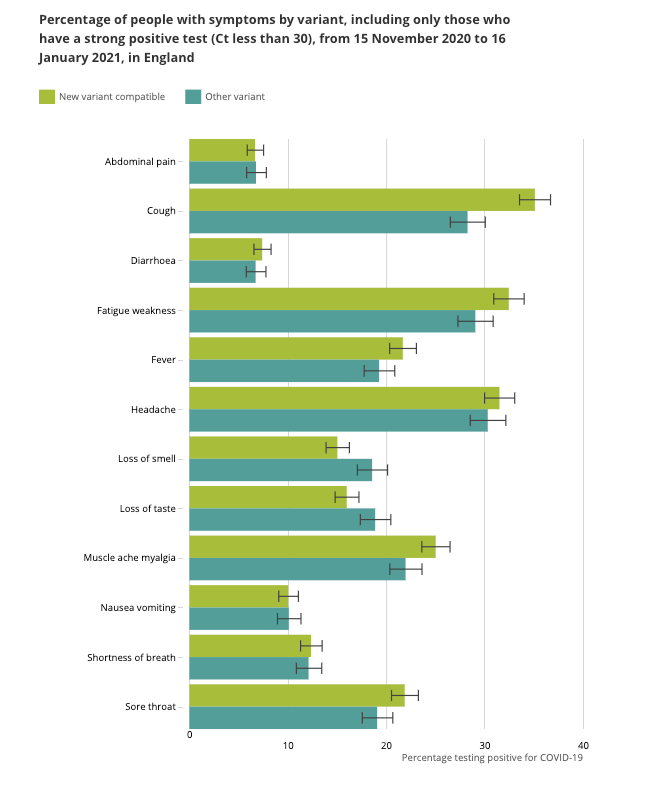The analysis looked at swab tests taken between November 15, 2020 and January 16, 2021, when the highest percentage of positive tests associated with the new variant were seen in London and the south east of England.
When a COVID-19 test is carried out, swabs are tested for three genes present in the coronavirus: N protein, S protein and ORF1ab. According to the ONS, absence of the S-gene in these tests appears to have become a reliable indicator of the new UK variant.
People testing positive were asked about the symptoms they’d experienced. The analysis found that loss of taste and loss of smell were significantly less common in new-variant compatible positive tests.
Other symptoms, however, were more commonly associated with this variant, with the largest differences noted for cough, sore throat, fatigue, myalgia (muscle pain) and fever, as well as a small increase in headaches.
There was no evidence of any difference in the prevalence of gastrointestinal symptoms (such as sickness and diarrhea), shortness of breath or abdominal pain.


Lawrence Young, a virologist and professor of molecular oncology at the University of Warwick in the UK, acknowledged that mutations in the UK virus variant could influence the symptoms associated with infection.
“This variant is more transmissible and infected individuals appear to have higher virus loads which means they produce more virus. This could result in more widespread infection within the body perhaps accounting for more coughs, muscle pain and tiredness,” he said. “The virus has 23 changes compared to the original … Some of these changes in different parts of the virus could affect the body’s immune response and also influence the range of symptoms associated with infection.”
Richard Tedder, a senior research investigator in medical virology at Imperial College London, suggested the change in symptoms ― especially those of upper respiratory tract infection, i.e. coughs and colds ― might also be the reason for its increased transmissibility.
“For example, if there is an increased amount of coughing and perhaps sneezing associated with a particular variant virus, these two activities can markedly increase the amount of virus which is shed into the environment, thereby making it ‘more infectious,’” he explained.
Even small changes in symptoms could influence a large change in the ease with which a virus can be transmitted between people, Tedder added.
“Either way, the most important feature is to remain distant from other people and wear facial covering able to reduce shedding of sneeze- and cough-generated droplets when outside the home,” Tedder said. “The old saying ‘coughs and sneezes spread diseases’ is as appropriate now as it was many decades ago.”
People are currently advised to have a test for COVID-19 if they present with one (or more) of three symptoms: a fever, new and continuous cough, or loss of sense of smell or taste. Back in September 2020, the five most common symptoms of Covid-19 reported to the UK’s COVID Symptom Study app were headache, fatigue, loss of smell, fever and a persistent cough.
Lead researcher Tim Spector, from King’s College London, told HuffPost UK at the time that the symptoms hadn’t significantly changed since the start of the pandemic. The COVID Symptom Study app confirms that fatigue, headache, loss of smell and persistent cough and sore throat are currently the most dominant symptoms of the virus.
This article originally appeared in HuffPost UK.
Experts are still learning about COVID-19. The information in this story is what was known or available as of publication, but guidance can change as scientists discover more about the virus. Please check the Centers for Disease Control and Prevention for the most updated recommendations.
Credit: Source link